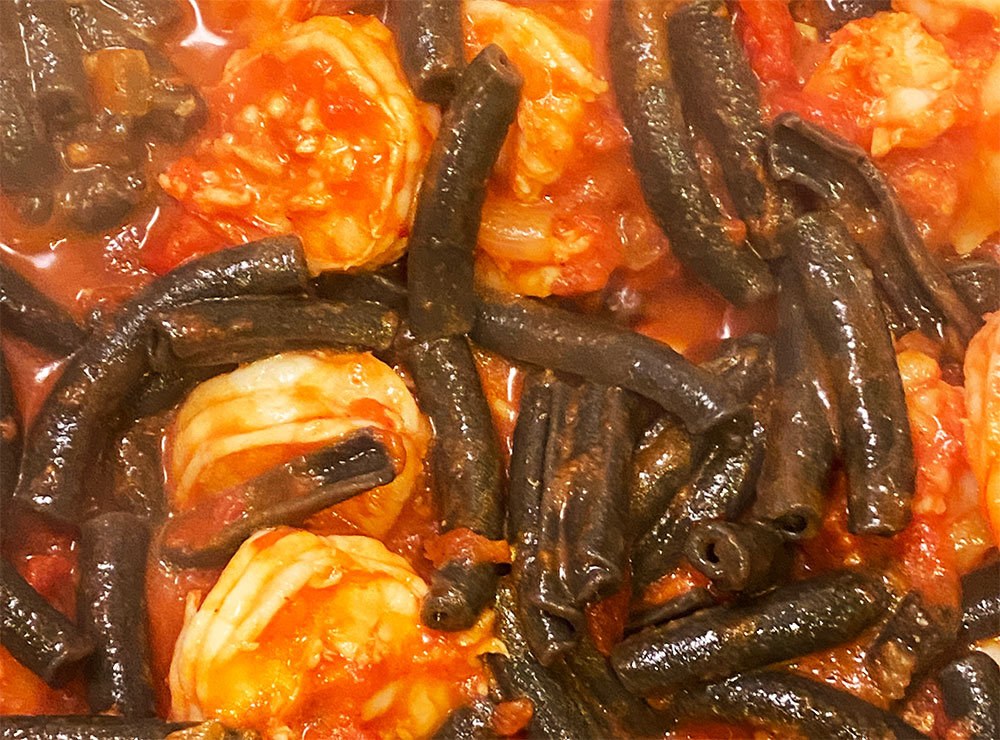Shrimp fra Diavolo
By Ian MacAllen on Tuesday, August 30th, 2022 at 8:08 am | 1,528 views

Lobster fra diavolo was an early Italian American invention combining large American lobsters with southern style flavors. Shrimp is a low cost alternative.
At the time, Maine lobsters were plentiful and a low-cost luxury. The “Fra Diavolo” was a nod to the spice of hot peppers — the phrase means with the devil.
The original preparations involved whole lobsters with a side of spaghetti. Eventually the lobster was served on top of the spaghetti.
As the price of lobster began to rise, cost cutting encouraged chefs to use less lobster — and that meant stripping the whole lobster from the shell in order to shortchange the customer and reduce the amount of meat in the dish. Shelling the lobster did make it easier to eat.
The evolution of the dish continued. Once the lobster meat had been removed from the shell, the pasta became more important, and the meat relegated to a component of the sauce. The sauce typically was tomato based and filled with spicy peppers.
Once the pasta became the focus of the dish rather than whole lobster, other shellfish became substitutes for lobster including crab, bay scallops, and shrimp.
I’ve made fra diavolo a few times now, but I’ve always used shrimp. (My wife doesn’t like scallops). Shrimp aren’t quite as buttery as lobster, but this is actually fine. With the hot spice of the dish, the nuanced flavor of lobster is less important. While the shrimp won’t have the same tenderness or sweetness of a lobster claw meat, the price of lobster these days makes the whole dish cost prohibitive.
I begin by cooking out a basic tomato sauce — canned tomatoes, onions, garlic, a little tomato paste — and then adding some heat. Crushed dried red pepper works great. In the photo above, I also added some sliced, pickled pepperoncini. The vinegar of the pickled peppers adds a little acidic flavor to the dish.
Astute observers will notice the pasta above is dark black. No, these aren’t charcoal flavored pasta, but instead cuttlefish ink pasta from Sfoglini. Sfoglini makes high quality pasta in the Hudson Valley, and I was the beneficiary of pasta of the month that included cuttlefish ink.
Pasta made from squid ink or cuttlefish ink is often served with seafood. The main component of squid ink is melanin, and some people believe the ink has properties that improve our health. It’s a common food additive in Mediterranean cooking, especially pasta. Cephalopod ink is high in iodine, and may trigger seafood allergies even in people who rarely experience them.
The real flavor benefit of the cuttlefish ink is the strong umami flavor — the flavor of savory.
The other important element here is properly cooking the shrimp. Toss them into the sauce a the end just before serving. The shrimp will cook in a simmer sauce within minutes, so make sure the pasta is close to finished before adding the shrimp. The sauce can stay on the heat a few extra minutes without burning, but the shrimp can easily be overcooked and turn to rubber.
With the shrimp cooked or nearly cooked, toss in the pasta and turn the stove off. Toss everything a few times and serve.
And don’t forget, combining cheese and seafood is considered a faux pas in Italian cuisine, so leave the parmigiana at home for this one. Crusty bread does pair well, however.
Ingredients
Canned tomatoes
Garlic
Red pepper flakes
Black pepper
Pickled preserved pepperoncini
Onion
Shrimp
Olive Oil
Pasta of your choice
Instructions
Peel and clean shrimp
Dice garlic and onion
Simmer garlic and onion in oil
Added diced pepperoncini
Season with red pepper
Pour in tomatoes
Simmer until sauce thickens
Season with black pepper, salt, red pepper
Add shrimp
Simmer until shrimp of finished cooking
Toss with cooked pasta
* Adding a dash of anchovy paste to the onions can bring added umami flavor, and up the savory component of the dish.
***
Check out some historic lobster fra diavolo recipes like this one from the 1950s and this one from the early 20th century.

